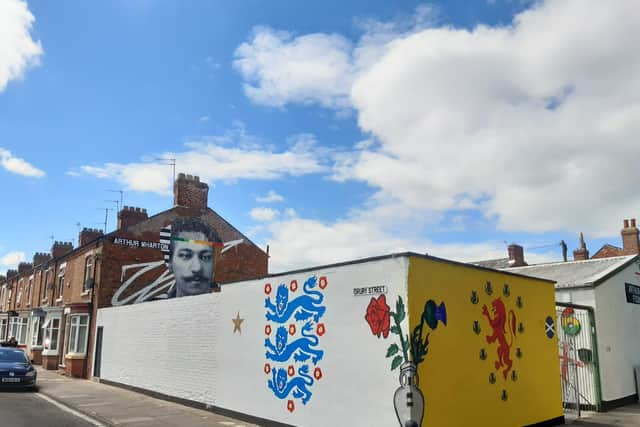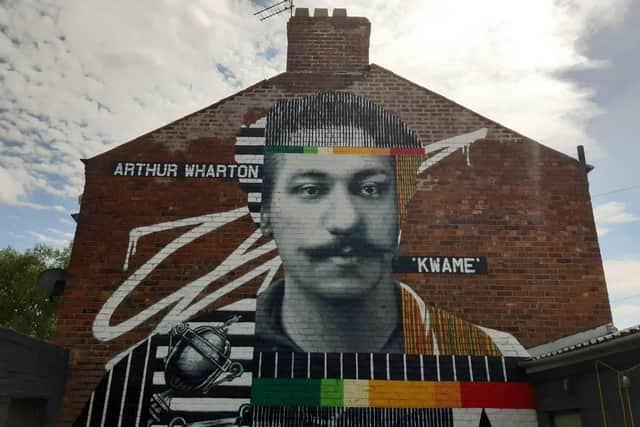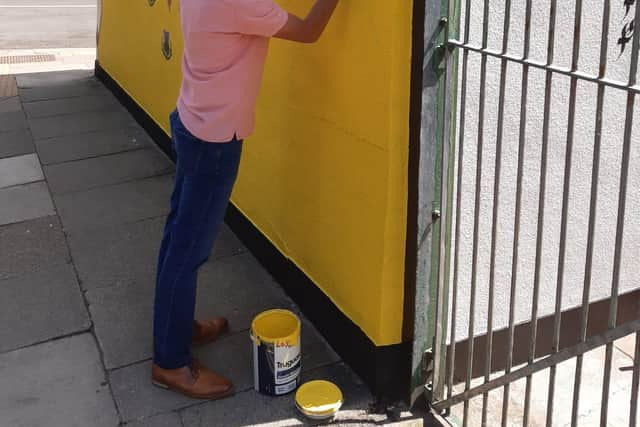Euro 2020: Why we should take note of Arthur Wharton, honoured in England but in fact a Scottish trailblazer
The truth is, while there is a 16-foot statue of Arthur Wharton at the England training HQ at St George’s Park where Gareth Southgate’s side have been preparing for tonight’s Euro 2020 clash with Scotland there is very little evidence north of the Border of the goalkeeper’s trailblazing status.
There’s certainly nothing so eye-catching as the magnificent mural painted on a gable wall in an unremarkable area of Darlington. Shaun Campbell wants to change that.
Advertisement
Hide AdAdvertisement
Hide AdOn a street with a Ladbrokes at one end and children’s play area at another, amid row after row of back-to-back 1900s terraced housing, the heart can only leap when the image of the handsome, moustachioed Wharton comes into view. Based in Darlington while covering Scotland’s Euro 2020 training camp, I took a walk to see the mural last weekend and met the irrepressible founder of the Arthur Wharton Foundation back there earlier this week.
Campbell told me that the painting, by Spanish graffiti artist Jay Kaes, was completed over four days at the height of lockdown last year to mark Black History Month.
The project was part financed by BT Sport, a company which identified with the Campbell-conceived motto: “Connecting the present to the past for the future.” This is daubed on a wall at the foundation, which occupies a building adjacent to the mural and serves as a busy community hub. Everyone seems well disposed to it, including the poor chap who answered the door to find Campbell on his doorstep with a request to slap a huge mural depicting a footballer from the late 1800s on the side of his house.
Recognising Campbell as someone who had helped in the effort to save Darlington FC from the club’s most recent financial meltdown in 2012, the owner gave his assent.
“It happened so quickly that we needed all the permissions from the council, the neighbours, you name it,” recalls Campbell, 59.


“I literally went to his door. A guy called Stewart answered the door. I said: ‘Hi, my name is Shaun, I have a guy from BT here – we want to put a mural on your house. It will be fantastic but if you don’t like it and no matter the expense to us and how much we like it, we will find a way of taking it off’. He just said: ‘do what you like!’”
The mural was unveiled on October 28, 2020 – the 155th anniversary of Wharton’s birth in 1865. It celebrates someone who became a local hero as goalkeeper for Darlington FC after originally moving from Ghana to become a Methodist preacher.
However, Wharton’s goalkeeping exploits are not the reason, or at least not the sole reason, why the England team bus will pass by a statue of him on the way to Wembley today.
Advertisement
Hide AdAdvertisement
Hide AdIt is not why some such as Marcus Rashford will perhaps nod in acknowledgment towards a figure depicted in the act of tipping the ball over the crossbar. Rashford is one of those who have a debt of gratitude to Britain’s first black professional footballer. Wharton turned professional with Darlington in 1889.


One slightly odd detail considering he is honoured at England’s training base is that Wharton is a lot more Scottish than English. In fact, he has no English blood at all. His mother, Annie Florence Grant, was the daughter of a Scottish merchant and a Ghanaian woman, while his father, the Rev Henry Wharton, was born in Grenada of Scottish and African heritage.
“It is a Scotsman who rises from the setting of St George’s Park in Arthur – he is Scottish Ghanaian, he ain’t English Ghanaian,” points out Campbell, whose father, from Barbados, moved to Britain as part of the Windrush generation, but whose surname can be traced to Scotland at the time of the slave trade. He is as passionate about black rights as he is about Wharton.
“Umpteen England national teams pass that statue every day – and at 16 feet tall, it is the tallest statue of any sportsman in the country," he continues. "It is not there as a gimmick. It is there to inspire, motivate…”
Campbell wonders why Wharton is not better known in Scotland, particularly given his other claims to fame: he enjoyed a glittering sports career, including becoming the world’s fastest man when winning a 100 yards race at Stamford Bridge in 1886.


Campbell has certainly emphasised Wharton’s Scottish heritage at the Saltire-festooned Arthur Wharton Foundation he established 11 years ago. It is a corner of Darlington that is forever Scottish, especially now.
A calligraphy artist has been busy adding Andrew Watson’s name to the wall. Wharton, while a pioneer on several fronts, was not the first black international footballer. This status does of course belong to Watson, who was recently the subject of a BBC documentary presented by former Rangers winger Mark Walters. On the day Scotland tread somewhat fearfully towards Wembley, it is comforting to note that Watson skippered Scotland to a 6-1 win over England in London in 1881: it remains the hosts’ biggest-ever defeat.
In addition, to mark Darlington’s more direct connection to the Scotland international team, James Morrison, who scored for Scotland at Wembley in a friendly in 2013, and was born in the town, has been recognised on this corner of fame, where two streets adjoin.
Advertisement
Hide AdAdvertisement
Hide Ad“The whole purpose of this kind of joining of the two countries is that it signifies the longest rivalry in international football, as declared by Fifa,” explains Campbell.
“Both of the teams came to stay in Darlington, at Rockliffe Hall. So it is a celebration of them coming to the North-east and that first rivalry. But also, in doing that, if we are celebrating the world’s first black professional footballer, then we also need to celebrate Andrew Watson, someone who I am incredibly passionate about and who played in Scotland eleven years before Arthur, but was not professional. I have been championing Andrew Watson as well – I have been in touch with the SFA board. I would like to see Scotland celebrate Andrew and I want to discuss that with the Scottish FA.”
As well as being an extraordinary riot of colour, the artwork is a deeply meaningful symbol of inclusiveness at a time when this issue is high on the agenda.
Scotland got themselves in a fankle before the tournament had even begun last week when the players announced an intention to stand prior to each game to demonstrate support for fighting discrimination in football and wider society.
The stance jarred with the intentions of the England team to continue to take a knee before games, with Andy Robertson, the Scotland skipper, releasing a subsequent statement on behalf of the players. It confirmed they will likewise take a knee “against ignorance and in solidarity” alongside the opposition this evening.
Che Adams, who became the first black player to represent Scotland at a major finals when he came on at half-time against Czech Republic on Monday, will be one of those kneeling.
Campbell believes Scotland should explore links to the black community elsewhere more thoroughly when scouting for players, noting how few non-white players have represented the Scottish international side since that promising start, when Watson led Scotland to a thumping win over England.
“We would love the Scottish team to come down here before they leave,” he said. “And hopefully that’s a while yet.
Advertisement
Hide AdAdvertisement
Hide Ad“Steve Clarke could be interviewed in front of the mural, maybe a couple of players. This is Scottish heritage right here. It is important.
“You have got the two most pioneering black presences in the world of sport, in Arthur, and in football in Andrew Watson – both black, both Scottish.
"Usain Bolt became a professional footballer for a while. There are only two men in history who have been the fastest man on the planet and a professional footballer – they are Usain Bolt and Arthur Wharton.”
